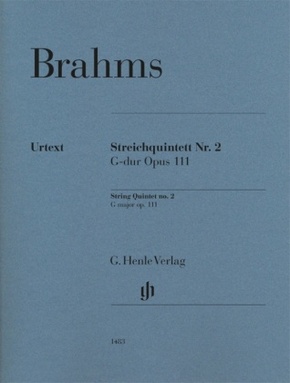
Johannes Brahms - Streichquintett Nr. 2 G-dur op. 111 - Besetzung: Streichquintette
| Verlag | Henle |
| Auflage | 2023 |
| Seiten | 82 |
| Format | 23,9 x 0,6 x 30,8 cm |
| Gewicht | 328 g |
| Reihe | G. Henle Urtext-Ausgabe |
| ISBN-13 | 9790201814834 |
| Bestell-Nr | 96302808BA |
Wie schon das Schwesterwerk Opus 88 im Jahr 1882, so sollte auch das zweite Streichquintett von Brahms acht Jahre später in der entspannten Atmosphäre der Sommerfrische in Bad Ischl vollendet werden. Auf die erste praktische Erprobung in Wien im Oktober 1890, die Brahms der Freundin Clara Schumann gegenüber als "nicht unlustig" bezeichnete, folgte im Austausch mit befreundeten Musikern wie Joseph Joachim das letzte Feilen am Werk, bevor Brahms seinem Verleger Simrock zum Jahresende Partitur und Stimmen für den Druck zusandte. Mit teils orchestraler Klangfülle und der für Brahms so typischen mitreißenden Rhythmik gewann das heiter gestimmte Werk schon früh die Herzen von Zuhörern wie Ausübenden, auch wenn es an Letztere durchaus gehobene Anforderungen stellt. Die Henle-Urtextausgabe basiert auf der Neuen Brahms-Gesamtausgabe, für deren Edition Herausgeberin Kathrin Kirsch neben den Erstausgaben auch sämtliche autographen Quellen herangezogen hat. Mit ihren durch Wendestellen und St ichnoten optimal für die Praxis eingerichteten Stimmen liefert die neue Urtextausgabe nun die optimale Grundlage zur Annäherung an dieses Juwel der Brahms'schen Kammermusik.
Inhaltsverzeichnis:
Streichquintett Nr. 2 G-dur op. 111
As with its companion work op. 88 from 1882, Brahms's second string quintet was supposed to be completed in the relaxed atmosphere of a summer in Bad Ischl, but eight years later. The work's first technical try-out in Vienna in October 1890, which Brahms described to his friend Clara Schumann as "not displeasing", was followed by a fine-tuning of the work in close dialogue with musical friends such as Joseph Joachim before Brahms sent score and parts to his publisher Simrock at the year's end. With its at times orchestral texture and stirring, typically Brahmsian rhythms, this cheerful work early on won the hearts of listeners and players alike, despite presenting the latter with some challenges. This new Henle Urtext edition is based on the New Brahms Complete Edition, for which editor Kathrin Kirsch has consulted all the autograph sources and first editions. With parts that have judiciously set page turns and cue-notes to facilitate performance, it offers the best foundation for approaching this jewel of Brahms's chamber music.
